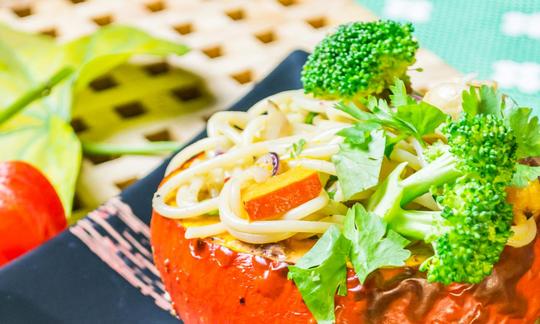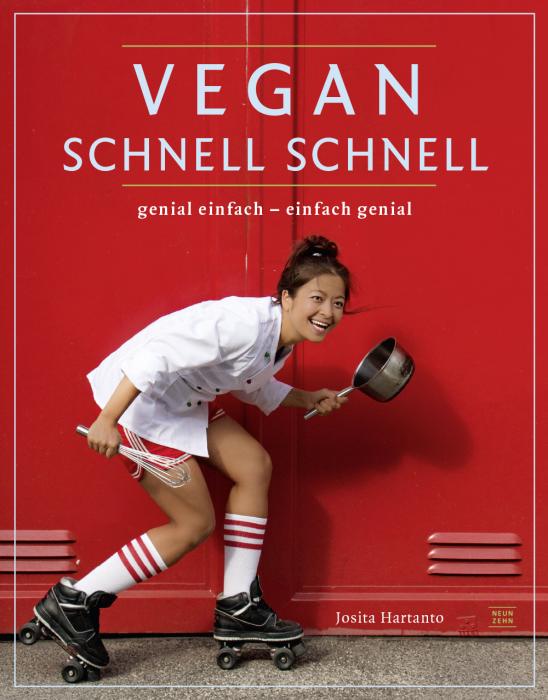Coconut and Pumpkin Noodles with Mushrooms and Broccoli
vegan
Ingredients (for servings, )
| For the noodles | |
|---|---|
| 8 ½ oz | Rice noodles, 'spaghettini' (organic?) |
| For the coconut and pumpkin sauce | |
| 5 ½ oz | Hokkaido pumpkins (Hokkaido pumpkins) |
| 1 | Onions, red (raw, organic?) (2.8 oz) |
| 2 tbsp | Rapeseed oil, refined (organic?) (0.98 oz) |
| 1 cup | Cultivated mushrooms, raw (organic?) (3.4 oz) |
| ½ | Broccoli, raw (brocoli, broccoli, broccoli, asparagus cabbage) (2.7 oz) |
| ¼ tsp | Chili powder (raw?, organic?) (0.02 oz) |
| 1 tsp | Real coriander, seeds (raw?, organic?) (0.06 oz) |
| 200 ml | Coconut milk, raw (coconut milk, organic?) (7.1 oz) |
| 1 dash | Table salt (table salt, raw?, organic?) (0.01 oz) |
| ½ | Limes, raw (organic?) (1.2 oz) |
| ½ bunch | Coriander leaves, raw (0.35 oz) |
| 2 tbsp | Pumpkin seeds, dried, raw (organic?) (0.70 oz) |
Equipment
- grater
- skillet (frying pan)
- stove
- citrus juicer (lemon squeezer)
- saucepan
- sieve
Type of preparation
- cook
- chop or grind
- squeeze
- can (bottle)
- sauté
- remove the skin
- grate (shred)
- drain
Preparation
For the rice noodles
Fill a saucepan with water and bring to a boil. Add some salt and the noodles and cook until the noodles are al dente. Save 150 mL of the cooking water — it will be used to make the sauce.This amount of cooking water is for a recipe that makes two servings.
For the coconut and pumpkin sauce
Wash the pumpkin. Cut in wedges and then cut these into thin slices that are about 3 mm thick. Peel the onion and cut into slices. Stir-fry the pumpkin and onion in hot oil for about 3 minutes.For a recipe that serves two, the author suggests using one medium-size red onion.
We have chosen to use canola for the oil and reduce the amount from 2 to 1 tablespoon.Clean the mushrooms and broccoli and add to the pan, stir-frying for another two minutes. Mix in the chili powder and ground coriander and let sweat briefly. Add the leftover cooking water and the coconut milk and let the sauce reduce for 5 minutes. Salt to taste.
In the original recipe, the author gives the option of using either chili powder or sambal oelek.
Zest the lime peel and squeeze the lime. Add both to the sauce. Coarsely chop the cilantro and add to the sauce along with the noodles.
Season and serve
Mix everything together well, season, and sprinkle with roasted pumpkin seeds. Serve immediately while warm.
|
Nutritional Information per person
Convert per 100g
|
2000 kcal | |
|---|---|---|
| Energy | 945 kcal | 47.3% |
| Fat/Lipids | 45 g | 63.6% |
| Saturated Fats | 24 g | 118.0% |
| Carbohydrates (inc.dietary fiber) | 124 g | 45.8% |
| Sugars | 9.0 g | 10.0% |
| Fiber | 9.2 g | 36.8% |
| Protein/Albumin | 17 g | 33.7% |
| Cooking Salt (Na:353.3 mg) | 897 mg | 37.4% |
| Essential micronutrients with the highest proportions | per person | 2000 kcal | |
|---|---|---|---|
| Min | Manganese, Mn | 2.3 mg | 116.0% |
| Vit | Vitamin K | 72 µg | 97.0% |
| Prot | Tryptophan (Trp, W) | 0.23 g | 91.0% |
| Min | Copper, Cu | 0.78 mg | 78.0% |
| Elem | Phosphorus, P | 521 mg | 74.0% |
| Vit | Vitamin C (ascorbic acid) | 56 mg | 70.0% |
| Fat | Alpha-Linolenic acid; ALA; 18:3 omega-3 | 1.4 g | 69.0% |
| Prot | Threonine (Thr, T, irreversibly transaminated) | 0.57 g | 62.0% |
| Min | Selenium, Se | 32 µg | 59.0% |
| Prot | Valin (Val, V) | 0.95 g | 59.0% |
Detailed Nutritional Information per Person for this Recipe
The majority of the nutritional information comes from the USDA (US Department of Agriculture). This means that the information for natural products is often incomplete or only given within broader categories, whereas in most cases products made from these have more complete information displayed.
If we take flaxseed, for example, the important essential amino acid ALA (omega-3) is only included in an overarching category whereas for flaxseed oil ALA is listed specifically. In time, we will be able to change this, but it will require a lot of work. An “i” appears behind ingredients that have been adjusted and an explanation appears when you hover over this symbol.
For Erb Muesli, the original calculations resulted in 48 % of the daily requirement of ALA — but with the correction, we see that the muesli actually covers >100 % of the necessary recommendation for the omega-3 fatty acid ALA. Our goal is to eventually be able to compare the nutritional value of our recipes with those that are used in conventional western lifestyles.
| Essential fatty acids | per person | 2000 kcal |
|---|---|---|
| Alpha-Linolenic acid; ALA; 18:3 omega-3 | 1.4 g | 69.0% |
| Linoleic acid; LA; 18:2 omega-6 | 5.2 g | 52.0% |
| Essential amino acids | per person | 2000 kcal |
|---|---|---|
| Tryptophan (Trp, W) | 0.23 g | 91.0% |
| Threonine (Thr, T, irreversibly transaminated) | 0.57 g | 62.0% |
| Valin (Val, V) | 0.95 g | 59.0% |
| Phenylalanine (Phe, F) | 0.83 g | 53.0% |
| Isoleucine (Ile, I) | 0.64 g | 52.0% |
| Leucine (Leu, L) | 1.2 g | 50.0% |
| Lysine (Lys, K, irreversibly transaminated) | 0.65 g | 35.0% |
| Methionine (Met, M) | 0.33 g | 35.0% |
| Vitamins | per person | 2000 kcal |
|---|---|---|
| Vitamin K | 72 µg | 97.0% |
| Vitamin C (ascorbic acid) | 56 mg | 70.0% |
| Vitamin E, as a-TEs | 5.8 mg | 48.0% |
| Vitamin B9, B11 (Folate, as the active form of folic acid) | 88 µg | 44.0% |
| Vitamin B3 (Niacin) | 4.1 mg | 26.0% |
| Vitamin B6 (pyridoxine) | 0.37 mg | 26.0% |
| Vitamin B2 (Riboflavin) | 0.35 mg | 25.0% |
| Vitamin B5 (Pantothenic acid) | 1.5 mg | 25.0% |
| Vitamin A, as RAE | 188 µg | 23.0% |
| Vitamin B7 (Biotin, ex vitamin H) | 11 µg | 21.0% |
| Vitamin B1 (Thiamine) | 0.21 mg | 19.0% |
| Vitamin D | 0.10 µg | 2.0% |
| Vitamin B12 (Cobalamin) | 0.02 µg | 1.0% |
| Essential macroelements (macronutrients) | per person | 2000 kcal |
|---|---|---|
| Phosphorus, P | 521 mg | 74.0% |
| Potassium, K | 1'039 mg | 52.0% |
| Sodium, Na | 353 mg | 44.0% |
| Magnesium, Mg | 144 mg | 38.0% |
| Calcium, Ca | 109 mg | 14.0% |
| Essential trace elements (micronutrients) | per person | 2000 kcal |
|---|---|---|
| Manganese, Mn | 2.3 mg | 116.0% |
| Copper, Cu | 0.78 mg | 78.0% |
| Selenium, Se | 32 µg | 59.0% |
| Iron, Fe | 4.9 mg | 35.0% |
| Zinc, Zn | 3.1 mg | 31.0% |
| Iod, I (Jod, J) | 15 µg | 10.0% |
| Fluorine, F | 0.44 µg | < 0.1% |
"Vegan quick quick - simply brilliant - brilliantly simple" includes innovative restaurant-quality dishes that you can prepare quickly and easily.
Since this book is written in German, a description is omitted here. If you are interested, please switch to German in the menu.
Cilantro, pumpkin seeds, and lime really round off these coconut and pumpkin noodles with mushrooms and broccoli.
Hokkaido pumpkins: Unlike most other pumpkins, the skin of a small Hokkaido pumpkin (1–2 kg) can be eaten and doesn’t need to be peeled. This is because it softens when it is cooked. Hokkaido pumpkin has a firm consistency, is low in fiber, and has a slightly nutty flavor. The orange color comes from the large amount of beta-carotene it contains, which our body can convert into vitamin A. It also has large amounts of vitamin B1, B2, and B6; vitamins C and E; as well as folic acid, magnesium, iron, and phosphorus.
Coconut milk is not coconut water: Coconut milk is made by puréeing coconut flesh with water and then straining through a cheesecloth. The result is a milky liquid that has a fat content of about 15 to 25 %. If you run boiling water over the fibrous pulp left behind and then squeeze the cheesecloth out again, you will obtain more coconut milk, but it will be somewhat thinner. Coconut water, not to be confused with coconut milk, is the clear liquid found inside young coconuts. Coconut milk is available commercially and is used as a milk substitute for tea, coffee, and baked goods.
Coriander seeds: Coriander seeds contain 60 % of the total amount of oil contained in the plant. The essential oils linalool and geraniol are primarily responsible for the refreshing, slightly lemony aroma of coriander seeds, which, however, only develops fully after the seeds are dried.
Lime juice: Raw lime juice, which contains lots of vitamin C, is added to a wide variety of dishes and drinks to give them a citrus taste. Compared to lemon juice, lime juice is more flavorful.
Cilantro: Some people react to its intensive, slightly soapy aroma with symptoms ranging from aversion to nausea. According to Swiss statistics, 15% of the allergic population reacts to cilantro. If you prefer, it is fine to simply leave the cilantro out.
Organic limes: If you are using lime peel in your cooking, be sure to buy organic limes that have not been treated with pesticides. If you don’t have organic limes, wash the limes before zesting them!
Less oil: We have halved the amount of oil used in the original recipe. For extensive information on reducing oil in your cooking, we recommend you read our review of Michael’s Moss’ book Salt Sugar Fat.




